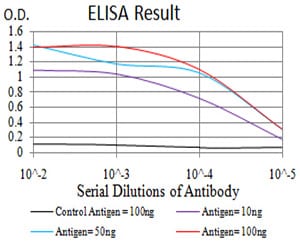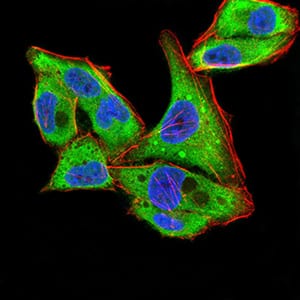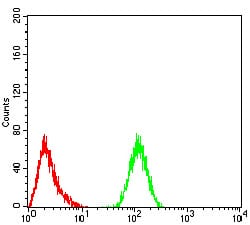




| WB | 咨询技术 | Human,Mouse,Rat |
| IF | 咨询技术 | Human,Mouse,Rat |
| IHC | 1/200 - 1/1000 | Human,Mouse,Rat |
| ICC | 1/200 - 1/1000 | Human,Mouse,Rat |
| FCM | 1/200 - 1/400 | Human,Mouse,Rat |
| Elisa | 1/10000 | Human,Mouse,Rat |
| Aliases | HS1; GW128; YWHAA; KCIP-1; HEL-S-1 |
| Entrez GeneID | 7529 |
| clone | 3D2E10 |
| WB Predicted band size | 28kDa |
| Host/Isotype | Mouse IgG2a |
| Antibody Type | Primary antibody |
| Storage | Store at 4°C short term. Aliquot and store at -20°C long term. Avoid freeze/thaw cycles. |
| Species Reactivity | Human |
| Immunogen | Purified recombinant fragment of human YWHAB (AA: 1-246) expressed in E. Coli. |
| Formulation | Purified antibody in PBS with 0.05% sodium azide |
+ +
以下是3篇与YWHAB抗体相关的参考文献及其摘要概括:
1. **《14-3-3 proteins regulate cullin-based E3 ligases by protecting adapters from SCF(β-TRCP)-mediated degradation》**
- 作者:Zhou, C., et al.
- 摘要:该研究揭示了YWHAB(14-3-3β)通过结合并保护E3泛素连接酶适配体蛋白,防止其被β-TRCP介导的泛素化降解,从而调控细胞周期和DNA损伤响应通路。文中使用了YWHAB抗体进行免疫共沉淀(Co-IP)验证蛋白相互作用。
2. **《YWHAB promotes glioma progression by regulating IL-6/JAK/STAT3 signaling》**
- 作者:Li, X., et al.
- 摘要:研究证明YWHAB在胶质瘤中高表达,并通过激活IL-6/JAK/STAT3信号通路促进肿瘤增殖和侵袭。实验通过Western Blot(WB)和免疫组化(IHC)结合YWHAB抗体,证实了其与胶质瘤恶性程度的相关性。
3. **《14-3-3β interacts with the Alzheimer’s disease-associated tau protein and modulates its phosphorylation》**
- 作者:Hashiguchi, M., et al.
- 摘要:文章发现YWHAB与阿尔茨海默病相关tau蛋白结合,并通过调节GSK-3β活性影响其异常磷酸化。研究中利用YWHAB抗体进行免疫荧光共定位分析,揭示了其在神经退行性疾病中的潜在作用机制。
4. **《Targeting 14-3-3β in cancer: A novel therapeutic strategy to disrupt survival pathways》**
- 作者:Porter, G.W., et al.
- 摘要:该综述总结了YWHAB在多种癌症中作为促生存蛋白的功能,强调其通过稳定促癌蛋白(如Raf-1和BAD)维持肿瘤细胞存活。文中引用了多篇使用YWHAB抗体进行功能研究的实验数据,支持其作为治疗靶点的潜力。
以上文献均涉及YWHAB抗体在分子机制或疾病模型中的应用,覆盖癌症、神经疾病等领域。
The YWHAB antibody is a tool used to detect and study the YWHAB protein, a member of the 14-3-3 family of conserved regulatory proteins. These proteins play critical roles in signal transduction, cell cycle regulation, apoptosis, and stress responses by binding to phosphorylated serine/threonine residues on target proteins. YWHAB (14-3-3β) is ubiquitously expressed and involved in diverse cellular processes, including neuronal development, cancer progression, and metabolic regulation. It acts as a molecular scaffold, modulating interactions between signaling molecules such as kinases, phosphatases, and transcription factors.
Antibodies targeting YWHAB are essential for investigating its expression, localization, and function in both physiological and pathological contexts. They are widely used in techniques like Western blotting, immunohistochemistry, and immunofluorescence to assess protein levels in tissues or cells. Dysregulation of YWHAB has been linked to diseases such as cancer, neurodegenerative disorders (e.g., Alzheimer’s), and metabolic syndromes, making its study clinically relevant.
Commercial YWHAB antibodies are typically monoclonal or polyclonal, validated for specificity and cross-reactivity across species (human, mouse, rat). Researchers rely on these antibodies to explore YWHAB’s role in signaling pathways, its interaction partners, and potential as a therapeutic target. However, challenges like batch variability or cross-reactivity with other 14-3-3 isoforms (e.g., YWHAZ) require careful validation in experimental setups.
×